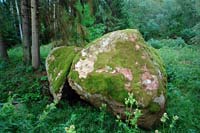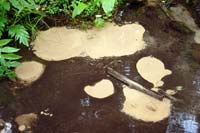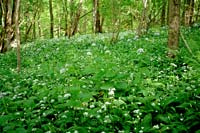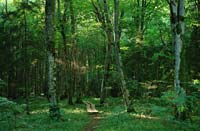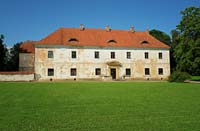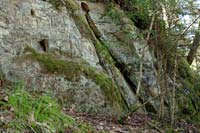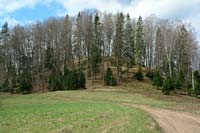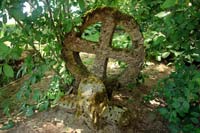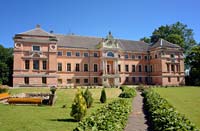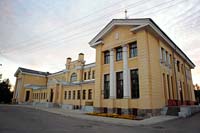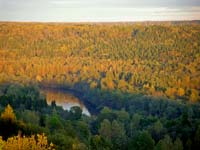Summary
Here author proposes a classification of landmarks. It is used in this website as well as in database of author. This classification is specifically adjusted to Latvian situtation. In a case of other countries there would be needed corrections in composition of categories - for example in New Zealand there are no medieval castles but contrary to Latvia New Zealand has got such landmarks as volcanoes, geysers and dendroglyphs (although also in Latvia there are specific traditional incisions in living trees). In a case of other countries there would be needed a thorough work at adjustments of border conditions for landmarks - for example in Iceland the girth of noble trees would be much smaller than in Latvia.
Units of classification
Units for division of landmarks can be arranged in three ranges:
- Type of landmarks - highest unit for division of landmarks. There can be identified two types with certainty - cultural landmarks and natural landmarks. Part of landmarks go in both types.
- Class of landmarks. Type of cultural landmarks can be divided in classes of archaeological landmarks and architecture landmarks, while natural landmarks can be divided in classes of geological landmarks and biological landmarks. Class of landscape landmarks belongs to both types of landmarks. Sites of legends go into separate category which is part of folklore heritage. Such category as museums belongs to all classes. The part of art heritage which is bound to a certain place also belongs to landmarks. Author has not classified landmarks of art thus far and examines them together with arhitecture and archaeological landmarks.
- Category of landmarks - in the work of author this is the "leading", most used range for division of landmarks.
There exist more detailed units for division of landmarks as well - these are defined on specific terms characteristic for certain category of landmarks. Below in short there are examined categories of landmarks met in Latvia.
Type: Natural landmarks
Class: Geological landmarks
Geological landmarks is object with certain, comparatively small area with certain location which causes interest due to its geological properties. In Latvia there can be identified geological landmarks of the following categories:
Category: Caves
Category includes all caves and niches which are deeper than 2 metres. In general the category includes only natural caves but in Latvian conditions many times it is hard to distinguish natural and artificial caves (the later ones included in category "Underground passages"). In a case of doubt the landmark is included in category of natural caves.
Part of the caves belongs also to archaeological landmarks - in a case of Latvia all of them fit in category "Worship sites". In some cases in caves there are petroglyphs - these are considered to be separate landmarks. Part of the caves is less known to public and as a result the unique environment of caves here has been preserved better - these caves will not be popularised in this Website.
Category: Outcrops and cliffs
Category includes those objects which correspond at least to one of these conditions:
- Natural outcrops of bedrock (ie. pre-quarternary rocks) whose height exceeds 1 metre and length - 2 metres;
- Impressive or unusual looking precipices;
- Outcrops of great importance for sciences of geology and geography;
Outcrops in Latvia often are lined along the banks of river - as two separate outcrops are considered those who are separated with a distance 50 metres and more. Petroglyphs which are found on some cliffs are considered to be separate landmarks.
Category: Boulders
Category includes those glacial erratics which exceed at least one of the following dimensions: volume exceeds 10 m3, length of stone exceeds 4 metres, height exceeds 2 metres. Category does not include those rocks which have split away from the outcrops and are located at their foot - such rocks are mentioned at corresponding outcrops.
Category includes also smaller stones with unusual features including also a group of archaeological monuments - those stones which have tales linked to them, which have cultural layer around them, who have got artificial incisions and cavities. If the major part of the surface of the stone is hewed - the stone belongs also to category of monuments.
Category: Springs
Category includes those natural springs which correspond at least to one of these conditions::
- Spring has got a discharge which is large enough - in a case of Latvia it exceeds 1 L/s;
- Spring water has got unusual chemical composition;
- Springs got culture historical value - f.e. there are folk tales and traditions connected to them, there are archaeological finds near them;
- Spring has got unusual location.
There are no hot springs in Latvia.
Category: Waterfalls
Category includes naturally shaped objects which correspond at least to one of these conditions::
- Locations where the elevation of water flow is changing abruptly and water is falling over natural steep. In a case of Latvia as a waterfall could be defined starting from 0,3 - 0,4 metre height if the fall is visually expressive;
- Locations where on a regular basis form visually expressive, vertical or nearly vertical ice falls;
- Visually expressive rapids including locations where a river or a stream crosses natural heaps of boulders.
Category: Other geological and geomorphological landmarks
Category includes all those geological and geomorphological landmarks which do not fit in other categories but are exciting from visual and/or scientific point of view.
Class: Biological landmarks
Biological landmark is an object with comparatively small area and certain location which is interesting due to its biological characteristics. In Latvia there can be proposed the following categories of biological landmarks:
Category: Unusual biotopes
Category includes comparatively small areas where are met unusual (for Latvia) compositions of plant and animal species and/or which have unusual looks.
Landmarks in this category can not be distinguished with certainty from such categories as "finds of rare plants" and "finds of rare animals" although the biotopes have more pronounced character of territoriality, sometimes unusual biotope consists of common species.
Category: Finds of rare animals
Category includes finds of those animals which are very rare in Latvia. Publicity can harm these landmarks and due to this they are not examined in this Website - with few exceptions in cases when these finds are widely known anyway and visitors can not harm them. Landmarks of this category on many occasions fit also in category "Biotopes".
Category: Finds of rare plants
Category includes finds of those plants which are very rare in Latvia. Publicity can harm these monuments and due to this they are not examined in this website - with few exceptions in cases when these finds are widely known anyway and visitors can not harm them. Landmarks of this category on many occasions fit also in category "Biotopes".
Category: Parks and gardens
Category includes those plantations which correspond at least to one of these conditions:
- Public gardens and parks;
- Manor parks;
- Botanical gardens and dendrological plantations;
- Distinguished private gardens and collections of plants which are available to public.
Landmarks in this category belong to similar extent to classes of biological landmarks and architecture landmarks.
Category: Trees
Category includes all those trees which correspond at least to one of these conditions:
- Dimensions of trees exceed criteria for noble trees set in 2nd Annex to Rules of Cabinet of Ministers No.415;
- Tree has got a cultural historical value;
- Treee has got a specific feature what makes it unique in Latvia.
Landmarks in this category can be included also in other categories, f.e. as "worship sites".
Type: Cultural landmarks
Category: Sites of legends
Category includes locations connected to certain tales. In most cases these locations are landmarks of architecture or archaeology but sometimes sites of legends do not have other peculiarities - f.e. crossroads, sections of roads, forest growes etc. Category belongs to type of cultural landmarks but does not fit in class of architecture or archaeological landmarks.
Class: Archaeological landmarks
In the class of archaeological landmarks there are included monuments of human past. They are distinguished from architecture landmarks with the following features:
- Evidence of former human activity is located below the ground or water. This border condition is not exactly precise - f.e. a shipwreck from 1920 is monument of archaeology but fundament of a building built in 1920 and destroyed shortly afterwards in general does not have any archaeological value;
- Each prehistoric construction and other artefacts also are archaoelogical landmarks - in a case of Latvia these would be any visible constructions shaped before the arrival of warriors of Christian orders in the beginning of 13th century;
- Archaeological landmark is also every landmark which is linked to religions and traditions which have not been inherited up to this day.
Sites of legends only partly could be considered to be archaeological landmarks because in many cases these legends are linked to contemporary events. In Latvia there could be identified the following categories of archaeological landmarks:
Category: Fortifications
Category includes all fortification up to younger times except for fortifications of hillforts and medieval castles. Could be disputed inclusion of the fortifications of younger times but in favour of this approach is the fact that none of these constructions are used now - all are abandoned. Number of landmarks in this category is small - thus there is no sense to divide it.
Category: Ancient burials (includes ancient graveyards)
Category includes all the prehistoric and medieval graveyards. A little bit problematic is the enormous number of stray burials but as each such find has its own value, also these burials are considered to be archaeology landmarks.
Category: Medieval castles
Category includes those castles which have been built in medieval times - until the end of 16th century. Sometimes these castles have survived up to this time, sometimes nothing remains. All these landmarks belong to category of architecture landmarks "Palaces and manor houses" as well - thus medieval castles could be considered to form a subcategory of this category. The special value of medieval castles makes it worth to designate a specific category for them.
Category: Medieval churches
Category includes those churches which have been built in medieval times - until the end of 16th century. Sometimes these buildings have survived up to this time, sometimes nothing remains. All these landmarks belong to category of architecture landmarks "Churches" as well - thus medieval churches could be considered to form a subcategory of this category. The special value of medieval churches makes it worth to designate a specific category for them.
Category: Petroglyph locations
Over the last decades there have been found petroglyphs in Latvia. Although it is hard to date these monuments and the meaning of signs is nearly indecipherable these landmarks have got aura of mystery around them and are very intriguing. Due to this each such find is considered to be a separate landmarks.
Petroglyph cliffs are very fragile and intentional damage has happened - due to this locations of these landmarks will not be popularised.
In category there are included also signs hewn in boulders which do not belong to contemporary alphabetes.
Category: Ancient settlements
Category includes remains of all prehistoric settlements and medieval settlements in whole area of these settlements. This category can be divided further in hillforts, lake forts, plain prehistoric settlements, medieval towns and other subcategories.
Category: Stray finds
Category includes those sites where have been found separate interesting ancient artefacts. This includes also ancient caches of values - deposits. Number of such landmarks is very large and the finds in general are not left on site - but these locations have scientific value.
Category: Underground passages
Category includes any underground passages which leave the borders of other buildings. Category includes any rooms made in bedrock (pre-quarternary rock) which are longer than 2 metres.
Not always it is easy to distinguish the artificial digs and natural caves - in a case of doubt the landmark is included in category "Caves".
Category: Worship sites
Category includes all landmarks linked to religions and traditions which have not been inherited up to this day. An exception is constituted by numerous monuments of health cults which are readily used by people nowadays as well - although the initial cult rituals most likely had different, forgotten meaning. Major part of worhip sites are also outstanding geological landmarks or noble trees - thus they fit in at least two categories.
Category: Other archaeological landmarks
Category includes all those archaeological landmarks which do not fit in categories above. For example in a case of Latvia here fit those few megaliths which we have got while in many other countries their number is higher and they would have their own category.
Class: Architecture landmarks
The name of class is simplified because it includes also industrial landmarks, immovable landmarks of technics and also large sized artworks which can not be considered to be buildings. Class includes those objects which correspond at least to one of these conditions:
- Landmark is created before 1900;
- Landmark has got expressive features of certain style of architecture and art and it is built before 1960;
- Landmark has got huge historical and public significance.
There can be defined also a subclass which includes industrial and technical landmarks (see below). In the class of architecture landmarks there can be identified the following categories:
Category: Cemetery architecture landmarks
Category includes outstanding examples of cemetery architecture. It is not sensible to include all monuments of separate graves here - in the category there are included mainly the most valuable public structures of cemeteries such as chapels, belfries, gates. Category includes also outstanding monuments of separate graves, graves of renovned people. Category includes those cultural historical stones which are connected with burials - such landmarks belong both to categories of boulders and cemetery architecture.
Category: Churches
Category has got a simplified name - but it includes sanctuaries of all contemporary religions including sinagogues and mosques. Category includes also locations of these buildings even if they have perished. All the sanctuaries are included including the newly built ones. Medieval churches are included also in their own category "medieval churches".
Category: Farmstead constructions
Category includes living houses and household buildings built before 1900 and located outside the borders of towns and manor centres. This includes also rural buildings which are moved over to open air etnographical museums in towns and cities. Although the name "farmstead" designates a group of buildings, landmarks are divided up to single buildings.
Category partly overlaps with the category "Buildings in manor centres", because manor centres do not have designated borders.
Category: Historical taverns
Category includes those architecture landmarks which have served as roadside and waterside taverns.
Category: Manor centre buildings
Category includes separate buildings in historical manor centres which were often planned according to specific development plans. Category has not strict border conditions because the policy of governance in manors was diverse. For example in many cases there were created also secondary manor centres - buildings of these centres are included in this category as well. Schools, mills, briges and taverns are included in their corresponding categories as well.
Category: Monuments
Category includes any monuments and memorial sites outside cemeteries and buildings.
Category: Monuments of urban development
Category includes impressive complexes of town buildings, developed under unitary structure an having an architectural and historical value. In spite of the name in separate cases there are included alsu complexes of rural buildings consisting of farmsteads belonging to different owners and also outstanding building and planning complexes in manor centres.
Category: Palaces and manor houses
Category includes all the palaces and manor houses built before the First World War - this includes also the locations of these buildings in cases when they have perished. Category has not got clear border conditions regarding, for example, pastorates, suburban villas of industrialists and owners of city land. Medieval castles are included both in this category and their own category "Medieval castles".
Category: Pastorates
Category includes all those valuable buildings and subsidiary buildings which have been built specially for pastors and buildings built for different activities of parishes. Category does not include churches.
Category: School buildings
Category includes all buildings which are built for educational purposes and correspond to conditions set to architecture landmarks.
Category: Urban apartment houses
Category includes all existing apartment buildings built inside the city and town borders which correspond to conditions set to architecture landmarks.
Category: Other architecture landmarks
Category includes all those architecture landmarks which do not fit in above mentioned categories.
Subclass: Industrial and technical landmarks
Definition of this subclass is based on the praxis of the conservation of industrial heritage. Major part of included landmarks are also valuable landmarks of architecture and the "classical" architecture landmarks have interesting technological details - for example heating systems, window casements, constructive solutions for the towers of churches. Still the landmarks in this subcategory to greater extent are interesting due technologies applied in their construction and use.
Category: Bridges
Category includes all bridges and flyowers which comply with conditions set for architecture landmarks.
Category: Industrial buildings
Category includes all industrial buildings which comply with conditions set for architecture landmarks.
Category: Mills
Category includes all preserved historical stationary energy production devices as well as the most significant and architecturally expressive contemporary energy production devices. As for most part this category consists of windmills and watermills, category has got a simplified name "mill".
Category: Railway constructions
Category includes those landmarks of technology and architecture which are connected with railway and tram system. Bridges, water towers and pumps belonging to railway belong also to their corresponding categories.
Category: Water supply management constructions
Category includes all water supply buildings which comply with conditions set for architecture landmarks.
Class: Landscape monuments
This class of landmarks is not particularly popularised and protected in Latvia but quickly diminishing number of picturesque views testifies that the approach here should be changed. Acknowledging that in this realm there is need for additional effort currently author divides landscape monuments in the following categories:
Category: Observation points
Category includes locations, where from small area there opens an exciting and/or beautiful view on larger area. Observation point can have natural ground or artificial base (observation decks).
Category: Linear landscape monuments
Category includes locations where expressive, fascinating landscape opens from linear route which is longer than 1 km.
Category: Vision slits
Locations where open impressive views on distant, prominent landmarks. These values of landscape shall not be classified as separate landmarks, they are subordinated to other landmarks.
Other categories
Category: Museums
Category includes all museums as well as such monuments of history as f.e. memorial rooms. These landmarks belong to all classes of landmarks.
References
- Pāvils G. Latvijas dabas un kultūras pieminekļu datu bāze.
- Pāvils G. Latvijas dabas un kultūras pieminekļu informācijas sistēma. Maģistra darbs. Rīga, 2004.


